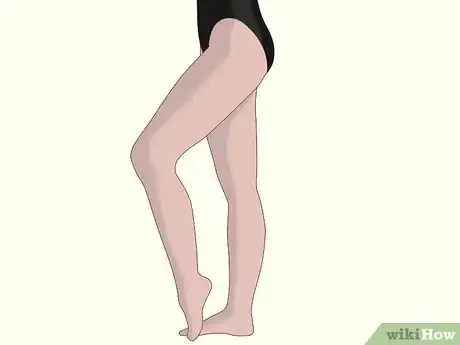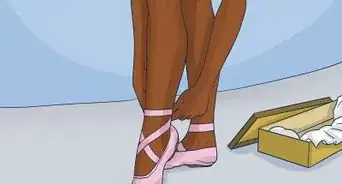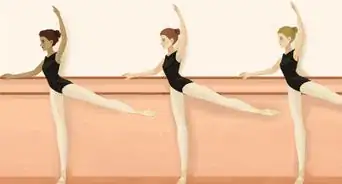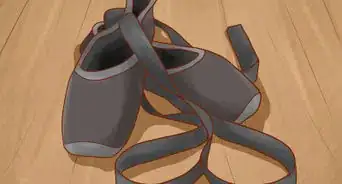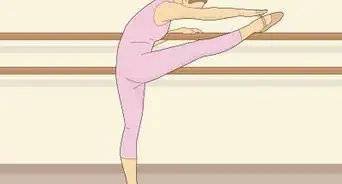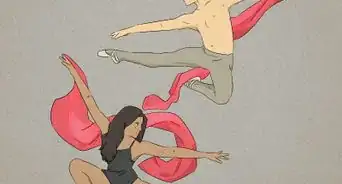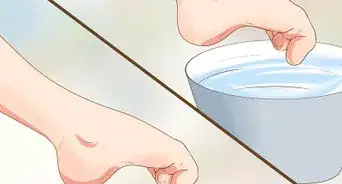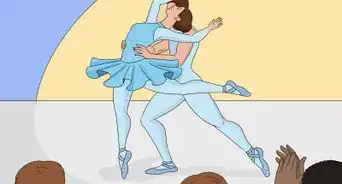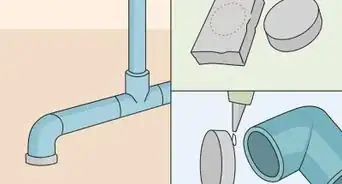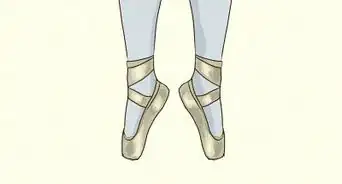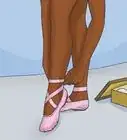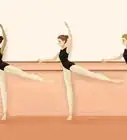This article was co-authored by Geraldine Grace Johns. Geraldine Grace Johns is a Professional Ballerina and the Owner of Grace Ballet in New York and Los Angeles. Geraldine toured through New Zealand, Australia, Japan, and Korea as Jammes in Ken Hill's Original Phantom of the Opera. She has studied with the Royal Academy of Dance in London to become a teacher and taught for the Kudo School of Ballet in Yokohama. Geraldine also ran her own Royal Academy of Dance School in New Zealand before studying at the Neighborhood Playhouse School of the Theatre in New York City. Geraldine was a guest coach and Master Class teacher in Toronto for the Canadian Royal Academy of Dance's Dance Challenge in 2018, 2019, and 2020. She was also a guest coach and Master Class teacher for the USA Royal Academy of Dance Challenge in Long Beach, California in 2019 and 2020. Grace Ballet Los Angeles has won recognition as one of 13 Best Ballet Schools in Los Angeles since opening her school. Geraldine is a contract Practical Teaching Supervisor for the Certificate in Ballet Teaching Studies for the Royal Academy of Dance.
There are 11 references cited in this article, which can be found at the bottom of the page.
wikiHow marks an article as reader-approved once it receives enough positive feedback. This article has 14 testimonials from our readers, earning it our reader-approved status.
This article has been viewed 367,818 times.
Ballet is an incredible workout, effectively strengthening muscles from your shoulders down to your toes. Stretching correctly is a super important way to protect your body while you improve your craft—and luckily, you've come to the right place. Below, we're walking you through all of the best pre-ballet stretches so you can keep your body in tip-top shape. Let's get started!
Steps
Stretching Your Muscles
-
1Prepare yourself and your stretching area. A designated stretching area and appropriate clothing will help you get the most out of the exercises.
- Have a designated area for stretching that is free of all clutter. If this isn’t possible, clear away any obstructive material (e.g. breakable china ornaments, expensive objects) from the area you will be using.[1]
- Wear comfortable clothes (such as a tracksuit or bike shorts over a leotard or tight-fitting crossover).[2]
- Pull long hair back into a ponytail or a bun so it isn't distracting.
- If you have hard floors you may want to use a mat for floor stretches.
-
2Warm up your hips and feet. It's especially important to move your hips and feet before you start moving. A simple way to warm up your hips is just to stand on one foot and swing the other leg back and forth. You can also lay on the floor, lift up one of your knees, and move it in circles to rotate your hip joint.[3]
- In addition, do circles with your feet, along with demi plies, plies, releves, and jumps to warm up your feet.[4]
Advertisement -
3Stretch your hamstrings. Sit on the floor with your legs extended in front of you. Touch your toes. If this hurts, then bend your legs slightly. Hold this position for 20 seconds. Repeat 2 times.
- Stretch your hamstrings in a standing position by crossing your ankles and bending forward as far as possible. Keep your feet together during the stretch. Hold for 20 seconds and then repeat, crossing your legs in the other direction.[5]
- Stretch your hamstrings by bending forward and placing your hands on the floor with your knees bent. Slowly straighten your knees without taking your hands off the floor.
-
4Stretch your feet. In a sitting position, place the foot you want to stretch over your thigh. With the hand closest to your heel, push into your heel. With your hand closest to your toes, place it over your toes and pull back so that your foot arches.[6]
- Allowing another person to stretch your feet may result in over-stretching and injury.
- Jamming your feet under a door or standing on top of your bent toes may cause injury.
- Use caution if using a foot stretcher.
-
5Use a ballet barre to do a bar stretch. Start in first position, with your left hand on the barre. Lift your right leg onto the barre with your ankle resting on it and your foot pointed. Lift your right hand to high fifth position and lean forward onto the right leg. Hold for 30 seconds then repeat on the other side.[7]
- Keep your back flat.
- Keep both legs turned out.
-
6Sit on your feet while in a kneeling position. Straighten one leg out in front of you (still sitting on the other foot) and point your toes. Touch your toes with both hands. Hold for 20 seconds. Repeat with the other leg.
Doing Splits, Lunges and Pirouettes
-
1Do jazz splits and bend forward so that your face touches your front leg. Start with the left leg in front and outstretched with your right leg bent behind you. Bend forward as far as possible. Slowly unbend your back leg (right leg). Hold for 30 seconds. Repeat with your right leg in front and left leg bent behind you.
- Practice to be able to do regular splits with both legs extended.
-
2Do right, left and center splits. Make sure you have perfect turn-out and point your toes. Hold each split for 20 seconds.[8]
- Do rights splits by putting your right leg in front of you and your left leg behind you.
- Do left splits by putting your left leg in front of you and your right leg behind you.
- Do center splits by extending each leg at a right angle to your body.
-
3Push your legs against a wall while in a straddle split. With your legs extended in a V in front of you, press your inside ankles against the wall, forcing your legs to stretch wider. Hold the stretch for 10-15 seconds.[9]
- Do not over-stretch. Stop if this exercise is painful.
- Do not over-stretch. Stop if this exercise is painful.
-
4Do splits while lying on your back. Lie on your back and put your feet up in the air. Cross your ankles then widen your legs into a split. Repeat 10 times, alternating the ankle cross.
-
5Do lunges for both legs. There are several kinds of lunges which can be done to stretch. Two of the most popular are Standard and Side lunges. Do 10-12 repetitions for each leg.[10]
- Standard lunges: Stand with legs hip-width apart. Maintain a straight posture. Step forward with one leg and lower your body until your front thigh is parallel to the floor. Your rear knee should touch or nearly touch the floor. Repeat with other leg.
- Side lunges: Stand with legs hip-width apart. Maintain a straight posture. Take a big step to your right side, bending your right knee and lowering your body until your right thigh is parallel to the floor. Your left leg should remain straight with your foot in contact with the floor. Repeat with the other side.
-
6
Expert Q&A
Did you know you can get expert answers for this article?
Unlock expert answers by supporting wikiHow
-
QuestionDo I need to warm up before I dance?
 Geraldine Grace JohnsGeraldine Grace Johns is a Professional Ballerina and the Owner of Grace Ballet in New York and Los Angeles. Geraldine toured through New Zealand, Australia, Japan, and Korea as Jammes in Ken Hill's Original Phantom of the Opera. She has studied with the Royal Academy of Dance in London to become a teacher and taught for the Kudo School of Ballet in Yokohama. Geraldine also ran her own Royal Academy of Dance School in New Zealand before studying at the Neighborhood Playhouse School of the Theatre in New York City. Geraldine was a guest coach and Master Class teacher in Toronto for the Canadian Royal Academy of Dance's Dance Challenge in 2018, 2019, and 2020. She was also a guest coach and Master Class teacher for the USA Royal Academy of Dance Challenge in Long Beach, California in 2019 and 2020. Grace Ballet Los Angeles has won recognition as one of 13 Best Ballet Schools in Los Angeles since opening her school. Geraldine is a contract Practical Teaching Supervisor for the Certificate in Ballet Teaching Studies for the Royal Academy of Dance.
Geraldine Grace JohnsGeraldine Grace Johns is a Professional Ballerina and the Owner of Grace Ballet in New York and Los Angeles. Geraldine toured through New Zealand, Australia, Japan, and Korea as Jammes in Ken Hill's Original Phantom of the Opera. She has studied with the Royal Academy of Dance in London to become a teacher and taught for the Kudo School of Ballet in Yokohama. Geraldine also ran her own Royal Academy of Dance School in New Zealand before studying at the Neighborhood Playhouse School of the Theatre in New York City. Geraldine was a guest coach and Master Class teacher in Toronto for the Canadian Royal Academy of Dance's Dance Challenge in 2018, 2019, and 2020. She was also a guest coach and Master Class teacher for the USA Royal Academy of Dance Challenge in Long Beach, California in 2019 and 2020. Grace Ballet Los Angeles has won recognition as one of 13 Best Ballet Schools in Los Angeles since opening her school. Geraldine is a contract Practical Teaching Supervisor for the Certificate in Ballet Teaching Studies for the Royal Academy of Dance.
Professional Ballerina & Ballet Instructor
-
QuestionWhat should I do if I don't have a barre to stretch on?
 Community AnswerThe back of a tall chair or a stable countertop usually works just as well as a barre.
Community AnswerThe back of a tall chair or a stable countertop usually works just as well as a barre. -
QuestionWhen stretching, I sometimes hear a click. What causes this?
 Community AnswerThat clicking sound Is most likely your bones popping. It's totally normal when you stretch.
Community AnswerThat clicking sound Is most likely your bones popping. It's totally normal when you stretch.
Warnings
- Be particularly careful if you have any known injuries. You may need to refrain from or modify some stretches.⧼thumbs_response⧽
- Follow the instructions of your ballet teacher.⧼thumbs_response⧽
- Some stretches can cause serious injury if done improperly or too intensely. Be careful and know your limits.⧼thumbs_response⧽
- Consult a doctor before starting any exercise program.⧼thumbs_response⧽
References
- ↑ http://www.bobvila.com/articles/279-design-a-home-gym/#.VSQMi_nF9e8
- ↑ http://www.huffingtonpost.com/2013/10/09/ballet-style_n_4064192.html
- ↑ Geraldine Grace Johns. Professional Ballerina & Ballet Instructor. Expert Interview. 11 November 2020.
- ↑ Geraldine Grace Johns. Professional Ballerina & Ballet Instructor. Expert Interview. 11 November 2020.
- ↑ http://www.webmd.com/fitness-exercise/video/gym-smarts-stretching-hamstrings-calves
- ↑ http://ballethub.com/how-to-stretch-your-feet-safely-easily-for-more-flexibility/
- ↑ http://ballet.isport.com/ballet-guides/a-ballet-dancers-guide-to-stretching-the-hamstrings
- ↑ http://www.womenshealthmag.com/fitness/how-to-do-a-split
- ↑ http://www.stack.com/video/1175866063/the-saddle-stretch-with-peyton-manning/
- ↑ http://www.self.com/flash/fitness-blog/2011/06/thigh-trimmers-5-new-ways-to-l/
- ↑ http://www.britannica.com/EBchecked/topic/461627/pirouette
- ↑ http://dictionary.reference.com/browse/demi%20pointe?s=t
- ↑ Geraldine Grace Johns. Professional Ballerina & Ballet Instructor. Expert Interview. 11 November 2020.
About This Article
To begin stretching for ballet, stretch your hamstrings by sitting on the floor with your legs extended in front of you and reach for your toes, holding for 20 seconds and repeating twice. Next, use a ballet barre and lift your leg onto the barre with your foot pointed. Lean forward with a flat back, hold for 30 seconds and repeat on the other side. You can also do right, left and center splits by extending your legs in opposite directions on the floor with perfect turn-out and pointed toes. Read on for other useful techniques including jazz splits, lunges and wall stretches.
